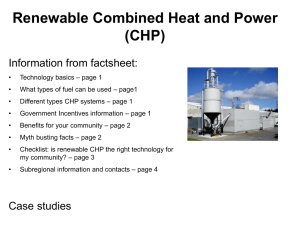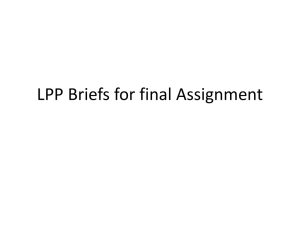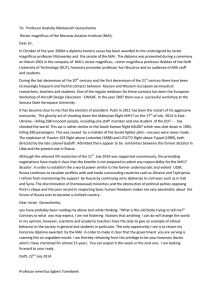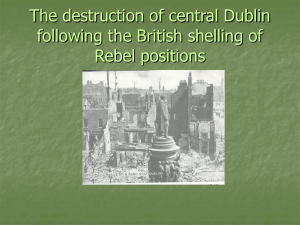CHP in Germany
advertisement
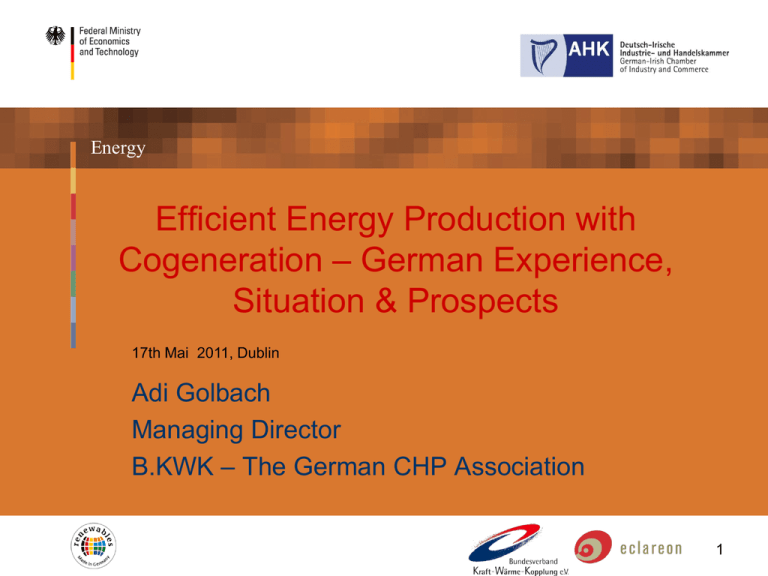
Energy Efficient Energy Production with Cogeneration – German Experience, Situation & Prospects 17th Mai 2011, Dublin Adi Golbach Managing Director B.KWK – The German CHP Association 1 Overview • • • • • B.KWK – The German CHP Association Facts & Figures Potentials & Problems Policy & Perspectives CHP examples in Germany 17th Mai 2011 Dublin 2 The B.KWK - The German CHP Association all kinds of operators all kinds of technologies all kinds of fuels all branches bundle forces integrates provides information interferes 17th Mai 2011 Dublin 3 Overview • • • • • B.KWK – The German CHP Association Facts & Figures Potentials & Problems Policy & Perspectives CHP examples in Germany 17th Mai 2011 Dublin 4 The Background Climate Change Ressource scarcity „Always look on the bright side of life.“ 17th Mai 2011 Dublin 5 The three bridges to sustainable energy supply 11 t CO2/a x Person Resource usage Higher efficiency CHP Renewable energy 2 t CO2/a x Person Change in needs 17th Mai 2011 Dublin 6 Energy streams in Germany Mt of hard coal equivalents 25% of PEC Source: Arbeitsgemeinschaft Energiebilanzen 2007 17th Mai 2011 Dublin 7 Systemvergleich KWK vs. getrennte Erzeugung 17th Mai 2011 Dublin 8 The Difference Power Plant 17th Mai 2011 CHP Dublin 9 The German heating market – a system of enormous wasting exergy heating energy other Electricity 3% 4% district heating 13% Gas 48% heating oil 32% 17th Mai 2011 • Conventional heating technology is squandering EXERGY • 70 °C heat produced from simply burning gas with 1100 °C squanders more than 80% of exergy • Electricity is pure exergy • So it‘s better to produce as much electricity as possible from fuels Dublin 10 CHP Fuels in Germany in Plants > 1 MW elt, 2005 Total 78 GWh Nat. Gas Hard Coal Lignite Mineral Oil Biomass & Waste Source: Eurostat 17th Mai 2011 Dublin 11 17th Mai 2011 Dublin Kroatien * Malta Norwegen Zypern Griechenland Frankreich Irland Vereinigtes Königr. Spanien Estland Slowenien 40% Schweden Bulgarien Luxemburg Italien Rumänien EU 25 Deutschland Portugal Belgien Tschechische Rep. Litauen Island Österreich Polen Ungarn Slowakei Niederlande Finnland Lettland Dänemark CHP in the EU CHP share in electricity production 2007 45% Source: EUROSTAT 2/2008 35% 30% 25% 20% 15% 10% 5% 0% 12 Overview • • • • • B.KWK – The German CHP Association Facts & Figures Potentials & Problems Policy & Perspectives CHP examples in Germany 17th Mai 2011 Dublin 13 CHP Potential in Germany (As of March 31, 2006) economically feasable up to 2020; fiction: no political barriers 17th Mai 2011 Dublin 14 Barriers against CHP • Lack of information about chances and technical details (sleeping giant) • Communal or industrial CHP in opposition to the strategic objectives of some big electricity companies • Very ambitious pay-back criteria in industry (< 3 years) • Unstable prospects regarding fuel security and prices 17th Mai 2011 Dublin 15 Benefits of CHP • • • • • Saves energy resources Climate protection Saves money in the medium and long run Reducing energy dependency Substitution of energy import expenditures by technical and economical knowledge • Creates new jobs • Higher electric grid stability, higher security of supply • Smart and flexible to operate 17th Mai 2011 Dublin 16 Overview • • • • • B.KWK – The German CHP Association Facts & Figures Potentials & Problems Policy & Perspectives CHP examples in Germany 17th Mai 2011 Dublin 17 2007 G8 Summit Declaration • The G8 Summit Declaration (June 2007) highlights cogeneration in the section on Energy Efficiency. • In section 70. Power Generation: „… adopt instruments and measures to significantly increase the share of combined heat and power (CHP) in the generation of electricity", 17th Mai 2011 Dublin 18 The German government‘s new energy and climate package from August 2007 Reduction up to 2020 in Mio. t/a CO2 equ Measures Doubling CHP share in electricity production to 25% 20 Reducing electricity consumption by 11 % 40 Substitution of old power plants by new ones 30 Higher share of RES in electricity production 55 Reducing energy consumtion of houses by modernisation of buildings and heating systems 41 Higher share of RES in heating 14 Higher efficiency in the traffic and rising share of bio fuels up to 17 % 30 Reduction of non-CO2 gases 40 17th Mai 2011 Dublin 19 New CHP act 2009 • Target: doubling CHP share in electricity production to 25% in 2020 • Focus on new installations being brought into operation by the end of 2016 • Bonus system again; paid finally by the electricity consumers (max. 0,3 Cent/kWh) • Bonus on electricity fed into the public grid or directly used > 2 MW elt -> 1,5 ct/kWh over 6 years or max. 30.000h, industry 4 years only 50 kW to 2 MW -> 2,1 ct/kWh over 6 years or max. 30.000h ≤ 50 kW -> 5,11 ct/kWh over 10 years • Max. 600 Mil €/a for CHP plants • Max. 150 Mil €/a for district heating investments (20% subsidy if at least 50% CHP heat) • Monitoring in 2011 • Start 1.1.2009 17th Mai 2011 Dublin 20 Renewable Electricity Act 2009 • • • • • Higher Bonus for CHP-electricity (3 ct/kWh) Technology Bonus for innovative CHP technologies Priority for grid-connection of CHP-plants Use of liquid biofuels only if sustainability certificated Practicable conditions for TPA of biomethane 17th Mai 2011 Dublin 21 21 Feed-in-tarifs for electricity from biomass Based on the Renewable Energy Act 2009 Biogas Biomethan 11,67 9,18 8,25 11,67 9,18 8,25 11,67 9,18 8,25 7 4 7 4 6 4 / 2,5 4 1 0 0 Technology bonus general Technology bonus gas processing 2 2 0-2 2 CHP bonus 3 3 3 Basic tarif < 150 kW < 500 kW < 5 MW Bonus for electricity from energy crops < 500 kW < 5 MW Manure bonus < 150 kW < 500 kW 17th Mai 2011 Dublin Biomass Cent/kWh 22 Renewable Energy Heat Act 2009 • Obligation to use pro-rata renewable energy (e.g. solar panels, pellets) • alternatively use of CHP heat (≥ 50 % produced in CHP) • Obligation for new buildings after 1.1.2009 • Legitimization of local district heating obligation by reason of climate protection 17th Mai 2011 Dublin 23 23 The governments energy plan • Sept. 2010: extension of the operating time of nuclear power plants by an average of 16 years 17th Mai 2011 Dublin 24 The governments energy plan Nuclear Power Plants in Germany • After Fukushima: • Reviewing the prolongation of the operating time of nuclear power plants • “„Energy turn” towards faster growth of renewable energy and higher efficiency 17th Mai 2011 Dublin 25 Energy Turnaround: The government new 6-point program 1. Quickly enhance Renewable energy Core of the energy turnaround is the rapid expansion of renewable energies. The wind energy has the biggest potentials. 2. Quickly develop electricity grids and storages ...to transport electricity from wind power plants in the north to the south. Expansion of flexible power stations and storage, serving to stabilize the power supply. 3. Consistently increase Energy efficiency By 2020 the heat demand of buildings shall be reduced by 20 percent. Encourage an ambitious renovation. 4. Quickly build flexible power plants In future, flexible power plants must offset the increasingly fluctuating power generation from renewable energy sources. Gas power plants have a special role. The construction of highly efficient and flexible power plants will be promoted in accordance with EU requirements. This is limited to operators whose share of the German power generation capacity is up to five percent. 5. Reorienting Energy Research The funds for research into networking and storage should be increased to 500 million € by 2020. 6. Participation of Citizens People should be fully involved to enable a broad dialogue on the necessity of restructuring the energy supply. 17th Mai 2011 Dublin 26 Perspective RE Development in Germany Trends in electricity generation from renewable energies 1991-2030, based on the Lead Study prepared by the DLR Institute for Technical Thermodynamics 27 The energy future will be decentralised Today Tomorrow: distributed/ on-site generation with fully integrated network management (INTELLIGENT GRIDS) 17th Mai 2011 cleaner, cheaper and more reliable Dublin 28 The new role of CHP: flexible electricity production complementary to wind and solar energy 17th Mai 2011 Dublin 29 Important but neglected: Information & PR Industry Economics by efficiency 17th Mai 2011 District heating Object CHP A lot of advantages but lack of awairness Big potentials & chances for many people Dublin 30 WESHALB DIE FERNWÄRME EINE DACHMARKE BRAUCHT! 6.11.2009 Demo-Kongress 2009 31 Overview • • • • B.KWK – The German CHP Association Facts & Figures Policy & Perspectives CHP examples in Germany 17th Mai 2011 Dublin 32 District heating CHP Stadtwerke Duisburg AG Plant I II / B III / A III / B, neu Operation since 1986 1967 1975 2005 fuel Operation up to Hard coal Hard coal Natural gas 2025 2012 2025 > 2030 elektr. capacity 102 MW 144 MW 41 MW 239 MW Therm. capacity 139 MW 163 MW 88 MW 167 MW Elect. production 2006 630 GWh 811 GWh 10 1238 GWh Heat production 2006 86 GWh 23 GWh 8 GWh 618 GWh 17th Mai 2011 Dublin Natural gas 33 Industrial CHP, 40 MW el. Chemical industry, Grenzach 17th Mai 2011 Dublin 34 34 Small scale CHP, 225 kW el. public swimming pool Schwäbisch Hall 17th Mai 2011 Dublin 35 35 Micro CHP, 5 kW el. „Dachs“ 12-appartment house 17th Mai 2011 Dublin 36 36 Summary and main results • Energy efficiency is a core element of a sustainable energy strategy • Conventional heat production in boilers is a big waste of exergy • CHP is a core element of an energy efficiency strategy • CHP is being discovered more and more by policy makers • CHP has a large potential - in Germany and anywhere • The Target of doubling CHP in Germany is a big chance for industry and investors • We have to make our choice on the future electricity production path – in fact environment tells us that we don’t have a choice • By using CHP potential and by overcoming barriers against CHP we may learn from each other 17th Mai 2011 Dublin 37 Energy Thank you for your attention! Consulting on CHP in Germany adigolbach@gmail.com 17th Mai 2011 Dublin 38


